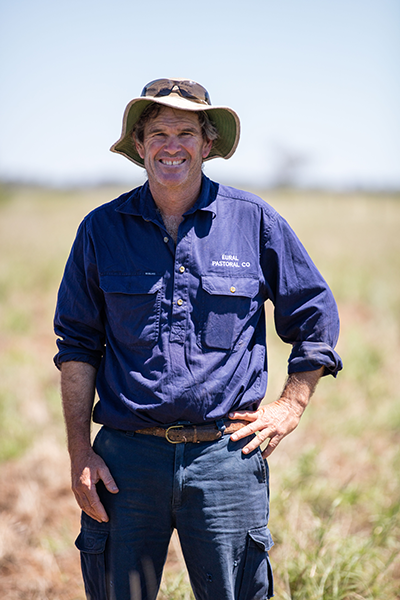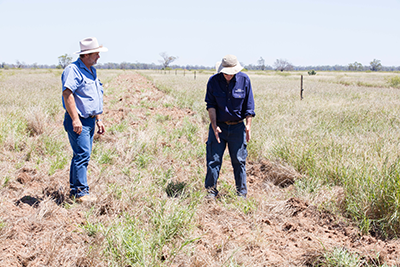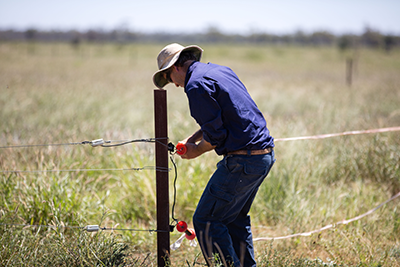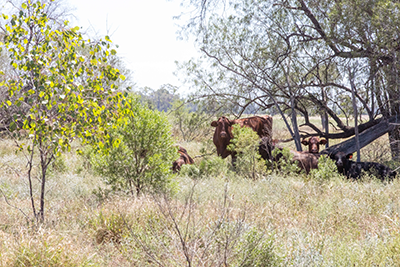A holistic management approach to improve natural assets
Being able to create a property that could maintain healthy production and endure the traditional boom and bust cycle is the dream of every grazier. John and Sam Hickson at ‘Eural’ near Boomi in North West NSW are progressing this dream to reality, as they ramp up the journey to phase in a new approach to regenerate soils and native pastures.

John Hickson from 'Eural', Boomi, NSW.
Working with nature
John says the change was driven by the realisation that under the traditional agricultural systems inputs would only continue to grow until finally a point would be reached where they would no longer be profitable. He grew tired of fighting the losing battle against big issues caused by climate variability and weed management. He says he has begun working with not against nature, to bring his production into line with the existing natural assets the landscape offers..
John’s family have farmed and grazed ‘Eural’ for three generations, starting with grazing, moving toward broadacre farming, and now there is a shift back towards sheep breeding which is complemented by trading cattle. The current journey began back in 2003 after John attended a Grazing for Profit workshop, with a move away from ‘traditional management’. More recently John has worked with North West Local Land Services to access advice and funding support to help get him closer to where he wants to be.
“There are some global figures around the amount and quality of productive soil left on the planet that make us think about our role,” John says.
“What we were doing didn’t seem to us to be sustainable in the longer term: as cropping took over so did our reliance on herbicides and inorganic fertilisers.
“In our grazing operation we could see loss of native pastures and declining soil health, which of course has a major impact on productivity.
“Even with good management we were very exposed to drought,” John says.
Holistic management
Based on what he’s learning from scientists, other landholders and Local Land Services and with many generations of land history and management to draw and reflect on, John refers to what he’s doing now as ‘holistic management’. Funding accessed under the North West Local Land Services' Check, Ready, Grow program has enabled works including fencing, multi-species planting and saltbush establishment to be undertaken.
The Check, Ready, Grow program focuses on the individual landholder’s business: where it is heading and what opportunities exist to help improve natural assets. The program helps landholders complete a self-assessment to identify their strengths, opportunities and guide project proposals with Local Land Services. Under the program, funding was made available to support the Hickson’s to further improve soil health, groundcover and drought resilience.

Keith Walker and John Hickson.
Working with Local Land Services
Working with Keith Walker from the North West Local Land Services over the past two years under the program, the results are already visible. Keith says combining passion with enterprise development and funding can be the catalyst for changing management and increasing sustainability.
“It’s not just the access to funding, it’s the access to knowledge as well,” John said.
“The project has provided capital for projects that are still really at the trial stage such as multi species pasture cropping and high establishment cost projects like saltbush.
“It also means we can prioritise works that would normally take us years to do, and at a much smaller scale.”
The multi-species planting undertaken through the project have provided cover for the return of native grasses and the decline of weeds. Some grasses haven’t been seen in these paddocks for some time and include Queensland blue grass, curly windmill and Mitchell grass. This groundcover is providing the essential blocks to build productive soil.

The Local Land Services funding for semi-permanent electric fencing has turned large paddocks into smaller cells of around 30 Ha.
Changing the paddocks
The paddocks are usually big out that way, but that’s changing. More refined grazing management is an aspect of John’s holistic approach and is common in regenerative agriculture. The Local Land Services funding for semi-permanent electric fencing has turned large paddocks into smaller cells of around 30 ha. This has required additional watering points.

More refined grazing management is an aspect of John’s holistic approach and is common in regenerative agriculture.
“Considering the usual size of our paddocks, this is quite a change for us,” John says, “but the fencing and extra watering points we’ve put in is making management easier and less stressful.
“Taking a holistic approach has lower costs attached, it requires less labour and the gains we see are
in increased profit, not necessarily productivity.
“Putting this management in place and the flexibility it affords allows us to bring our production and natural assets together.
“We are breaking the cycle of flogging paddocks then spraying the weeds that replaced the grasses.
“We used to chip and spray Bathurst burrs but now I don’t worry about them: with rest incorporated into our managed grazing regime we have very little bare ground which leaves no room for the burrs to establish.”
This project is supported by North West Local Land Services through funding from Catchment Action NSW.
Want more information?
Download a copy of the case study PDF, 646.41 KB.